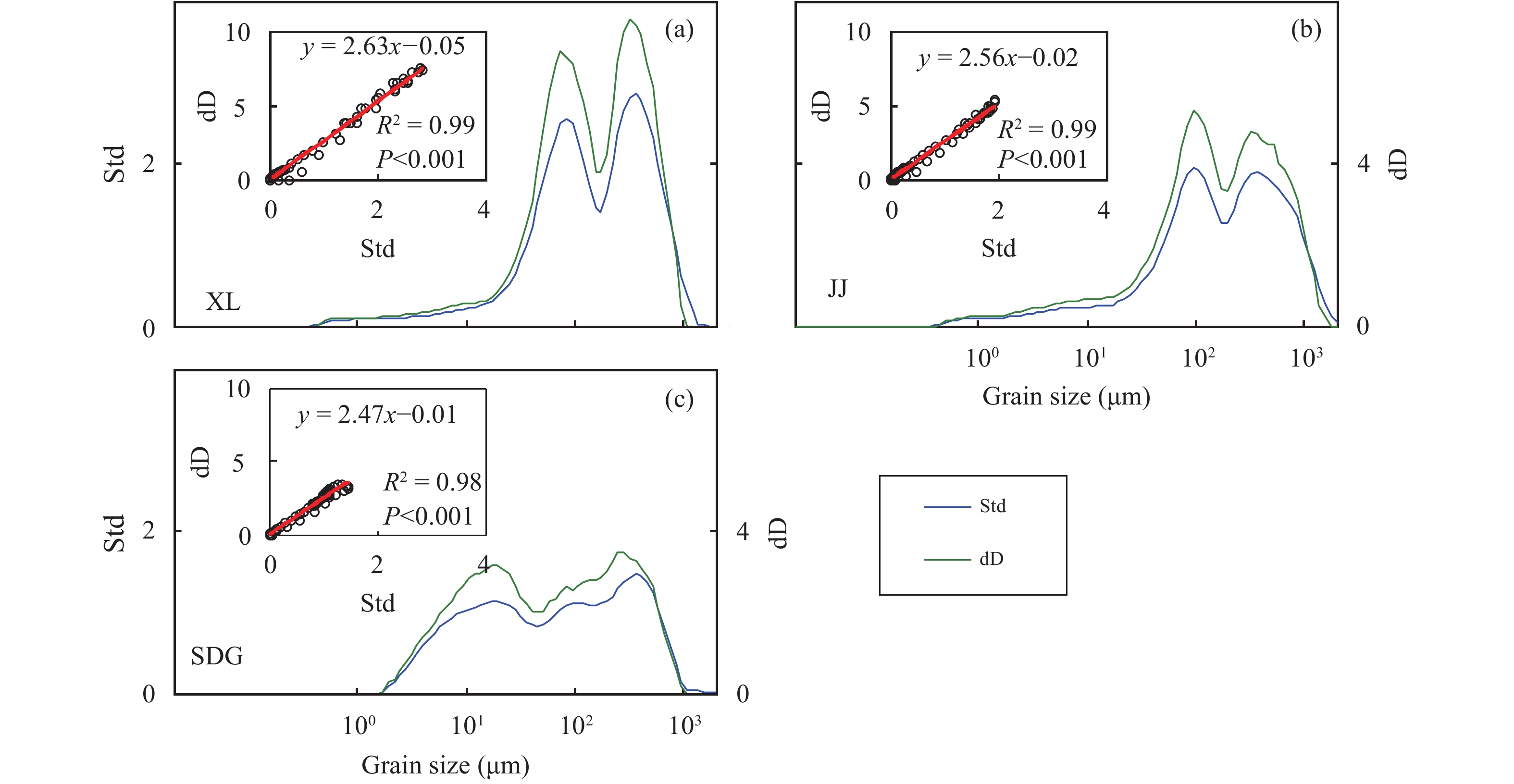Sciences in Cold and Arid Regions ›› 2018, Vol. 10 ›› Issue (5): 413–420.doi: 10.3724/SP.J.1226.2018.00413
Comparison of two classification methods to identify grain size fractions of aeolian sediment
YanZai Wang1,2,3,*( ),YongQiu Wu2,3,MeiHui Pan2,4,RuiJie Lu2,3
),YongQiu Wu2,3,MeiHui Pan2,4,RuiJie Lu2,3
- 1 College of Geography and Tourism, Chongqing Normal University, Chongqing 401331, China
2 State Key Laboratory of Earth Surface Process and Resource Ecology, Beijing Normal University, Beijing 100875, China
3 Engineering Center of Desertification and Blown-Sand Control, Ministry of Education, Beijing Normal University, Beijing 100875, China
4 College of Geography and Environment Science, Northwest Normal University, Lanzhou, Gansu 730070, China
| 1 |
Cheng H, He JJ, Xu XR, et al. Blown sand motion within the sand-control system in the southern section of the Taklimakan Desert Highway. Journal of Arid Land 2015; 7: 5 599- 611.
doi: 10.1007/s40333-015-0126-9 |
| 2 | Du SH, Li BS, Niu DF, et al. Grain-size distribution characteristics of red sandy sediments in Dongjiang River Valley, southern Nanling Mountains, during the MIS2 stage. Sciences in Cold and Arid Regions 2009; 1: 5 443- 447. |
| 3 |
Guan QY, Pan BT, Li N, et al. An indicator of sand storms in the south of the Tengger Desert. Theoretical and Applied Climatology 2010; 102: 1–2 197- 203.
doi: 10.1007/s00704-010-0252-4 |
| 4 |
Guan QY, Zhang JD, Wang LJ, et al. Discussion of the relationship between dustfall grain size and the desert border, taking the southern border of the Tengger Desert and the southern dust deposit area as an example. Palaeogeography, Palaeoclimatology, Palaeoecology 2013; 386: 1- 7.
doi: 10.1016/j.palaeo.2013.01.017 |
| 5 | He Q, Yang XH, Huo W, et al. The characteristics of grain size from the Kumtag Desert and its environmental significance. Sciences in Cold and Arid Regions 2009; 1: 2 128- 134. |
| 6 | Huang YZ, Wang NA, He TH, et al. Process of historical desertification of Mu Us Desert and relationship between nature and human beings. Scientia Geographica Sinica 2009; 29: 2 206- 212. |
| 7 | Liao XX, Li S, Wang GY, et al. Grain-size features of aeolian sand on the east coast of Hainan Island and the revealed evolutionary processes of the sedimentary environment. Sciences in Cold and Arid Regions 2010; 2: 6 538- 546. |
| 8 |
Liu B, Jin HL, Sun Z, et al. Extraction of sensitive grain-size component from the KE peat deposit of the Gonghe Basin and its implication for Holocene climatic and environmental change. Marine Geology & Quaternary Geology 2013; 33: 4 125- 134.
doi: 10.3724/SP.J.1140.2013.040125 |
| 9 | Liu B, Jin HL, Yang F A late Holocene winter monsoon record inferred from the palaeo-aeolian sand dune in the southeastern Mu Us Desert, northern China. Sciences in Cold and Arid Regions 2016; 8: 5 388- 399. |
| 10 |
Long H, Wang NA, Ma HZ, et al. Eolian activity and environment evolution history recorded by the Qingtu lake, NW Tengger Desert. Acta Sedimentologica Sinica 2007; 25: 4 626- 631.
doi: 10.3969/j.issn.1000-0550.2007.04.018 |
| 11 | Lu RJ, Wang YJ, Zhang DS Climate changes and desert evolution of Mu Us Desert since 15 ka BP. Journal of Desert Research 2010; 30: 2 273- 277. |
| 12 | Ma L, Wu JL, Jilili A Environmental changes inferred from environmentally sensitive grain-size component records in Chaiwopu lake, Xinjiang. Acta Sedimentologica Sinica 2012; 30: 5 945- 954. |
| 13 | Niu GM, Qiang MR, Song L, et al. Change of eastern Asian winter monsoon recorded by aeolian deposits over the past 5000 years at the southeastern margin of Qaidam Basin. Journal of Desert Research 2010; 30: 5 1031- 1039. |
| 14 |
Nottebaum V, Lehmkuhl F, Stauch G, et al. Regional grain size variations in aeolian sediments along the transition between Tibetan highlands and north-western Chinese desert–the influence of geomorphological settings on aeolian transport pathways. Earth Surface processes and Landforms 2014; 39: 14 1960- 1978.
doi: 10.1002/esp.3590 |
| 15 |
Pan MH, Wu YQ, Zheng YH, et al. Holocene aeolian activity in the Dinggye area (Southern Tibet, China). Aeolian Research 2014; 12: 19- 27.
doi: 10.1016/j.aeolia.2013.10.005 |
| 16 |
Roskin J, Katra I, Blumberg DG Particle-size fractionation of eolian sand along the Sinai-Negev erg of Egypt and Israel. GSA Bulletin 2014; 126: 1–2 47- 65.
doi: 10.1130/B30811.1 |
| 17 | Wang YZ, Zhang CL, Dong YF, et al. Grain-size characteristics of Aeolian deposits and sediment action in prevent-sand system of Taklimakan Desert Highway. Journal of Arid Land Resources and Environment 2009; 23: 12 94- 102. |
| 18 |
Wang YZ The particle size changes and its dynamic implication within the shrub barriers of desert highway in arid area. Quaternary Sciences 2013; 33: 2 376- 387.
doi: 10.3969/j.issn.1001-7410.2013.02.20 |
| 19 |
Xu SJ, Pan BT, Gao HS, et al. Analysis of grain-size populations with environmentally sensitive components of loess during the last interglacial-glacial cycle and their implications. Acta Pedologica Sinica 2006; 43: 2 183- 189.
doi: 10.3321/j.issn:0564-3929.2006.02.002 |
| 20 |
Xu SJ, Pan BT, Gao HS, et al. Changes in sand fractions of Binggou section and the expansion and contraction of the Tengger Desert during 50–30 ka. Earth Surface Processes and Landforms 2007; 32: 3 475- 480.
doi: 10.1002/esp.1439 |
| 21 |
Xue JB, Zhong W Variations in dust event reflected by grain-size component of lacustrine records in droughty area: a case study on Barkol Lake, Xinjiang, China. Acta Sedimentologica Sinica 2008; 26: 4 647- 654.
doi: 10.14027/j.cnki.cjxb.2008.04.010 |
| 22 |
Zhu BQ, Yu JJ, Qin XG, et al. Formation and evolution of sandy deserts in Xinjiang: the palaeo- environmental evidences. Acta Geographica Sinica 2013; 68: 5 661- 679.
doi: 10.11821/xb201305008 |
| No related articles found! |












